"PPC for Plastic Surgeons: A Complete Guide to Growing Your Practice"
PPC (known as Google AdWords) is a powerful advertising platform that can help plastic surgeons reach potential patients actively searching for cosmetic surgery services.
When used effectively, it enables you to place targeted ads in front of people looking for procedures like rhinoplasty, breast augmentation, or tummy tucks, driving high-quality traffic and converting them into consultations and patients.
This guide will walk you through everything from setting up your PPC for plastic surgeons campaign to optimizing it for the best results.

Why PPC for Plastic Surgeons are so Effective?
Google Ads work exceptionally well for plastic surgeons because of its intent-based advertising model. When a potential patient searches for plastic surgery services, they often have a specific need in mind. Here’s why it works:
- Targeting Intent: People searching for procedures (like “facelift near me”) are highly motivated and ready to make a decision.
- Local Relevance: Google allows you to target users in specific geographic locations, ensuring your ads are only shown to people within your service area.
- Measurable ROI: Google Ads provides detailed analytics, allowing you to measure performance and optimize for the best return on investment.
Step 1: Setting Up Your Google Ads Account
To get started, you’ll need a Google Ads account. If you don’t already have one, visit and sign up.
1. Set Up Your Campaign:
- Choose the Search Network campaign type to show text ads in Google’s search results.
- Name your campaign something relevant like “Plastic Surgery Patient Acquisition.”
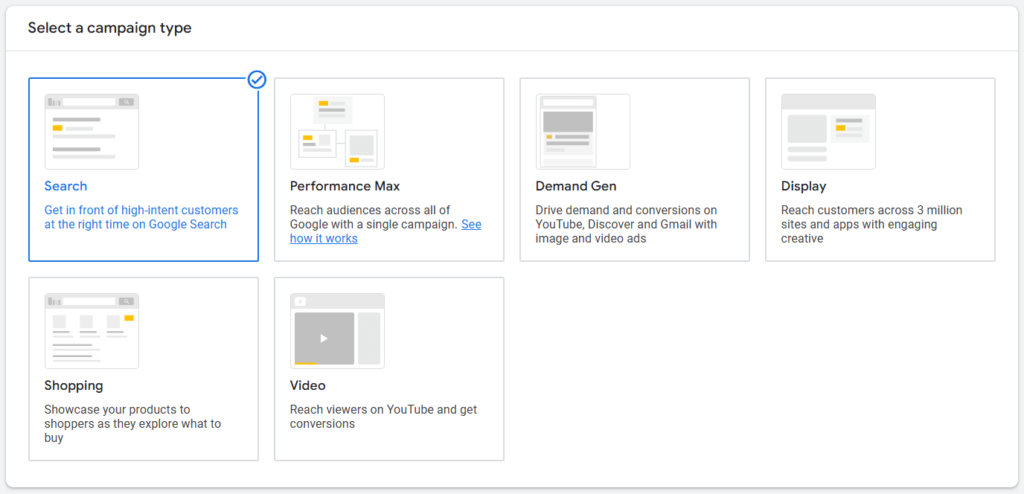


2. Choose Your Campaign Goal:
- Select a campaign goal that aligns with your objectives. For plastic surgeons, the most common goals are Lead Generation or Website Traffic, both aimed at driving consultation requests.

3. Set Your Daily Budget:
- Start with a conservative budget and increase it as you see which ads perform well. A good starting point is around $50-$100 per day, depending on the competition in your area.

4. Set Your Bid Strategy:
- Choose a bidding strategy that focuses on conversions. Maximize Clicks or Target CPA (Cost-Per-Acquisition) is usually effective when you’re just starting.
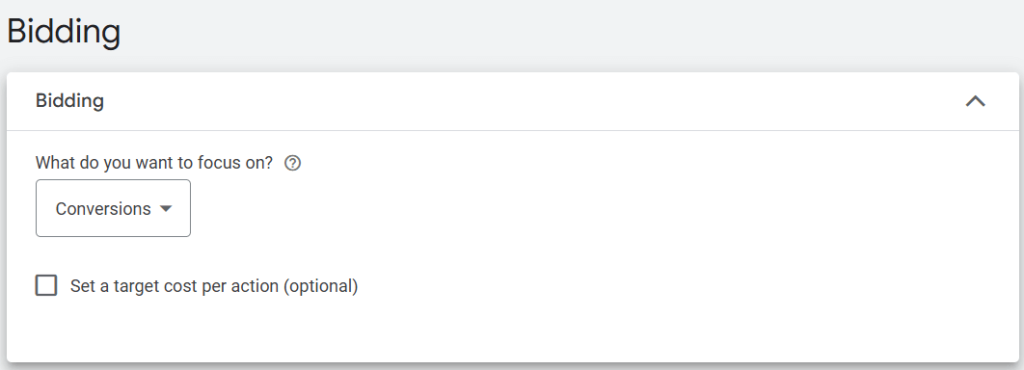
Step 2: Keyword Research for Plastic Surgeons
Choosing the right keywords is essential for getting your ads in front of the right audience. Keywords should be highly relevant to the services you offer and the specific procedures patients are searching for.
Types of Keywords:
1. Procedure-Based Keywords:
- Examples: “rhinoplasty near me,” “breast augmentation in [city],” “facelift cost”
- These are search terms directly related to your services. These keywords are often higher in intent and conversion rates because users are specifically looking for a plastic surgeon.


2. Symptom-Based Keywords:
- Examples: “fix droopy eyelids,” “reduce belly fat,” “correct nose bump”
- These keywords target users who may not know exactly which procedure they need but are searching for solutions to specific issues.
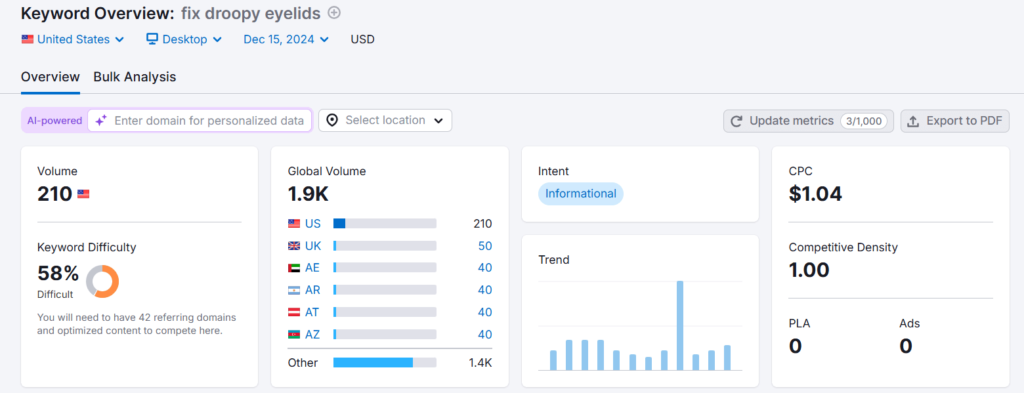
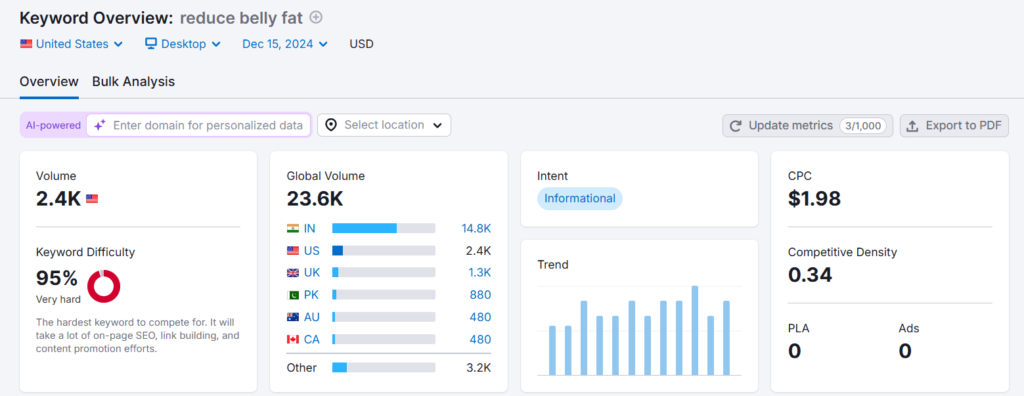
3. Location-Based Keywords:
- Examples: “plastic surgeon near me,” “best plastic surgeon in [city]”
- Local search intent keywords are crucial for plastic surgeons because patients typically want services within a reasonable distance.


4. Long-Tail Keywords:
- Examples: “what is the recovery time for rhinoplasty,” “how much does a tummy tuck cost”
- These are more specific queries that can attract patients further down the decision-making funnel.


Using Keyword Tools:
Step 3: Writing Effective Ad Copy for Plastic Surgeons
Your ad copy is what convinces potential patients to click on your ad and take action. The key to writing compelling ad copy is to focus on the benefits of your services and address the needs and concerns of your audience.
Ad Copy Best Practices:
1. Use Keywords in Your Ad:
- Include your target keywords in both the headline and description of your ad to increase relevance.
- Example: “Looking for a Skilled Plastic Surgeon? Book a Free Consultation for [Procedure] in [City]!”
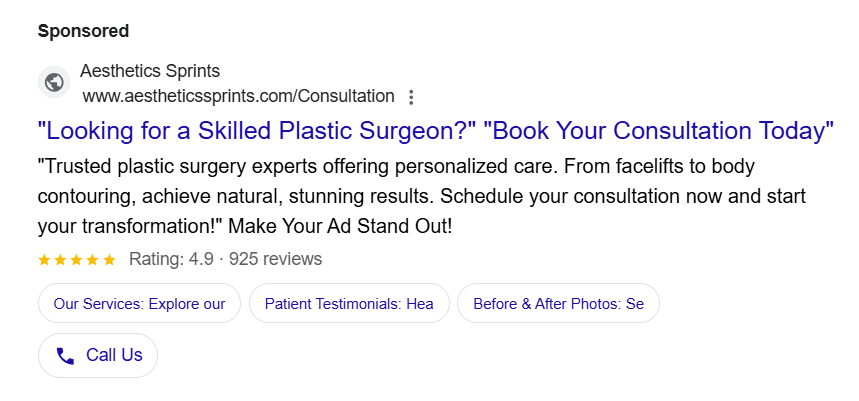
2. Highlight Unique Selling Propositions (USPs):
- Mention what sets you apart from other plastic surgeons, such as years of experience, certifications, or advanced techniques.
- Example: “Over 10 Years of Experience in Breast Augmentation & Rhinoplasty. Board-Certified Surgeon.”
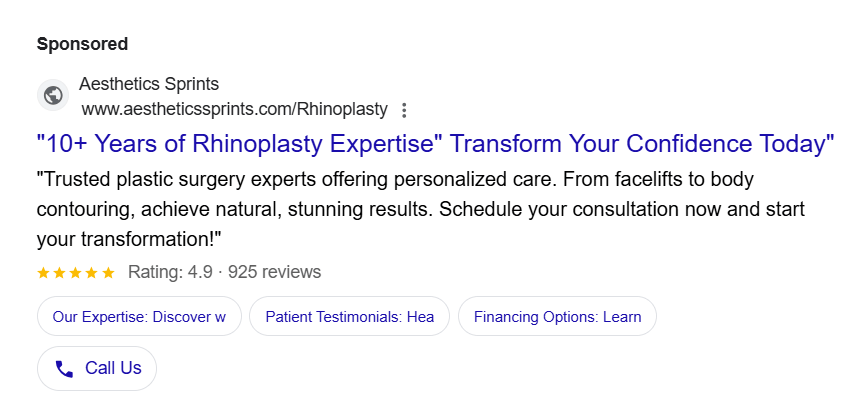
3. Incorporate a Strong Call-to-Action (CTA):
- Your CTA should guide users to the next step, whether it’s booking a consultation or calling your office.
- Example: “Schedule Your Free Consultation Today” or “Call Now to Learn More About Our Procedures.”
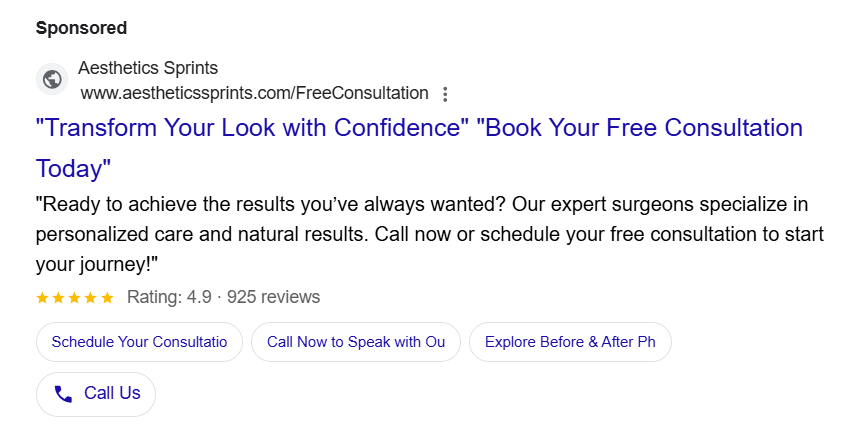
4. Address Patient Concerns:
- Many patients are concerned about safety, recovery times, or cost. Address these concerns in your copy.
- Example: “Safe & Effective Rhinoplasty with Minimal Downtime. Financing Available.”
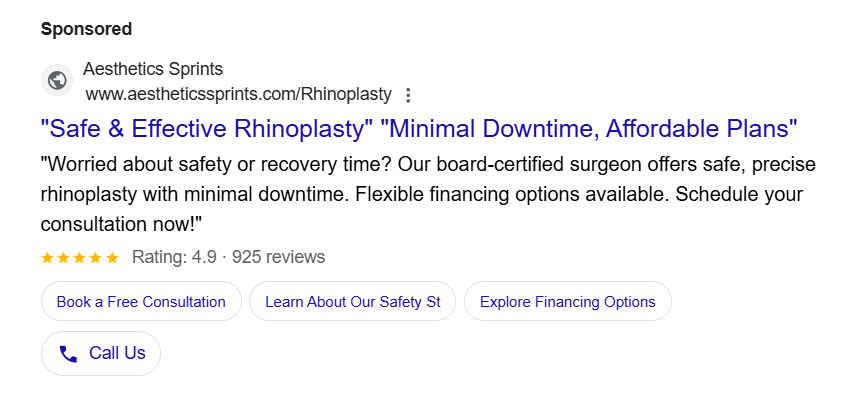
Step 4: Setting Up Ad Extensions
Ad extensions provide additional information and increase your ad’s visibility, making it more likely to be clicked. Here are a few ad extensions ideal for plastic surgeons:
1. Call Extension: Add your phone number to encourage potential patients to call directly from the search results.
2. Location Extension: Show your practice’s address to attract local patients. This helps with trust and local relevance.
3. Sitelink Extensions: Direct users to specific pages on your website, such as “Before and After Photos,” “Patient Testimonials,” or “Meet Our Surgeon.”
4. Callout Extensions: Highlight unique benefits, such as “Board-Certified Surgeon,” “Free Consultation,” or “Flexible Financing.”
Step 5: Targeting Your Audience
Plastic surgery is typically a local business, so you’ll want to use geographic targeting to ensure your ads only appear for users near your practice.
Geographic Targeting:
1. Set Location Radius:
- Target users within a specific radius (e.g., 10-50 miles) of your practice. This ensures your ads are shown to people who can realistically visit your office.
2. Location-Based Bid Adjustments:
- Increase bids for users in your immediate area or affluent neighborhoods, as they are more likely to convert.
Device Targeting:
- Target Mobile Users:
- Many users will search for plastic surgery services from their smartphones. Ensure your ads are optimized for mobile users by using mobile bid adjustments and mobile-friendly landing pages.
Step 6: Creating a Conversion-Optimized Landing Page
Your Google Ads campaign should lead to a well-designed landing page that is optimized for conversions. This is where users will go to learn more about your services and book a consultation.
Key Elements of a High-Converting Landing Page:
1. Consistent Messaging:
- Ensure that the landing page matches the ad’s offer. If your ad is about rhinoplasty, the landing page should focus solely on that service.
2. Call-to-Action (CTA):
- Place a clear, prominent CTA like “Schedule Your Free Consultation” at the top of the page. Include the CTA multiple times as users scroll.
3. Before-and-After Photos:
- Showcase real patient results to build trust. Make sure you have consent to use these photos and consider using a slider or gallery format.
4. Patient Testimonials:
- Include reviews or video testimonials from satisfied patients. This social proof can significantly boost conversions.
5. Contact Form:
- Include a simple, short contact form with fields for the patient’s name, phone number, email, and the service they are interested in. Offering a free consultation in exchange for filling out the form is a great incentive.
Step 7: Setting Up Conversion Tracking
Tracking conversions is crucial to understanding how well your Google Ads campaigns are performing. Set up conversion tracking to monitor actions like form submissions, phone calls, or consultation bookings.
How to Set Up Conversion Tracking:
1. Google Ads Conversion Tag:
- Install a Google Ads conversion tracking tag on your website’s thank-you page (the page a user lands on after submitting a form or booking a consultation).
2. Phone Call Tracking:
- Use call tracking to measure phone calls generated from your ads. This is particularly important for plastic surgeons, as many patients prefer to book consultations via phone.
3. Google Analytics Integration:
- Connect Google Analytics to your Google Ads account to gain deeper insights into user behavior and track additional goals like page views or time spent on your site.
Step 8: Budgeting and Bidding Strategy for Plastic Surgeons
Plastic surgery is a competitive field, and your cost-per-click (CPC) will reflect that. However, since the average patient value for plastic surgery is high, the return on investment can be substantial.
Conclusion: Maximizing Google Ads for Plastic Surgeons
Google Ads can be a game-changer for plastic surgeons looking to attract more patients.
By targeting the right keywords, writing compelling ad copy, optimizing your landing pages, and tracking conversions, you can build an effective, high-ROI advertising campaign.
Remember that success with Google Ads requires regular monitoring and adjustments, from optimizing your bids to refining your targeting based on data insights.
When done correctly, Google Ads allows you to reach potential patients right when they’re actively searching for the services you offer, making it one of the most powerful tools in your digital marketing arsenal.
Stay consistent, track your performance, and make data-driven decisions to ensure long-term success in patient acquisition.

About the Author: Jatin Thakur
Jatin Thakur, founder of Aesthetics Sprints, is a seasoned digital marketer with 8+ years of experience helping plastic surgeons attract patients and grow their practices. Specializing in Local SEO, PPC Ads, and Social media marketing strategy, Jatin empowers aesthetic professionals to thrive in a competitive market.
"Ready to Attract More Patients to Your Practice?"
Grow your practice with tailored marketing that attracts and converts the right patients. From building your online presence to crafting high-converting campaigns, we specialize in driving real results for plastic surgeons.



